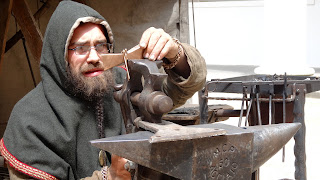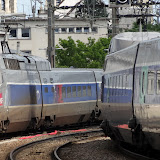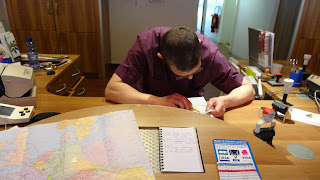Ghislaine kindly drops me at Dieppe Station well in time to catch the 0801 train to Rouen. It's a bit early for breakfast, so I have popped out to the local boulangerie for some wonderfully buttery croissants to eat en route. The first attempt nearly ends in a delayed departure, when they decide to stop the traffic to open the bridge to let a fishing boat out.
As always, I have enjoyed Dieppe and one little booklet, 'A taste of Dieppe' has been especially useful. Produced by expat, Peter Avis, it's a really insightful guide to where to go in the local area. I have been using the 2011 edition; I very much hope they have the foresight and the budget to produce another.
There are clear signs in Dieppe that the area is feeling the financial squeeze, with many shops, restaurants and offices shuttered or on offer for sale or rent. I am sure the area will recover, because it really does have a lot to offer.
There are no problems on the first legs of the long train journey, although I am a bit disappointed that the Rouen to Paris sector is fulfilled by an old style loco and carriages. But it's quiet enough, except that, as we approach the French capital, dozens of folk pile through to the front of the train to save a few seconds in exiting. I stay put till they are out of the way.
My transit between Gare Saint Lazare and Gare de l'Est in Paris is easily achieved with one stop on the RER Line A and one stop on the metro (€1.70) , although there is a tricky moment when one of my trolley bags gets wedged between a closing ticket gate..
I have never felt totally comfortable on the RER; there always seems to be some scary looking people around. But it's mid-morning and things are pretty quiet.
I am, rather frustratingly, routed to Frankfurt via Stuttgart and try again to change it to the more direct option. But, just as I have found to be the case before, there are plenty of seats, just nothing available for InterRail pass holders.
The enormous train is made up of two 12-coach TGV's, which will separate in Strasbourg. We are served lunch which comes in a rather natty little box. Wine, beer and coffee too, with repeats on request. As I have paid a whopping 33€ supplement for the seat reservation, I feel justified in exercising my right!
At Frankfurt, the transfer between French TGV and German ICE is a matter of simply crossing the platform. The interior design of the German Railways; ICE high speed trains remain my favourite in Europe; all wood, stainless steel and glass, with each carriage having a mix of compartments and open seating.
I enjoy a cup of English Breakfast Tea in the very quiet carriage. I ask if I can purchase the DB china mug. The girl tells me in perfect English that it's not possible, but later returns to present me with one 'as a gift from the staff'. It's a much appreciated gesture and will make a splendid souvenir of my trip.
In Frankfurt, there's a bit of a dilemma. My train, the Interlaken to Berlin ICE; is showing as departing from both platforms 8 and 9 at the same time. It's rush hour, the place is packed and I can't find any handy German Railways' staff to advise me. So I gamble and, luckily, as soon as I board, find a handy German Railways' travel guide, to show me that I am on the right train. But I never did manage to find out exactly what was going on.
I have decided to break the journey at a town called Fulda, simply because ten hours is enough travelling for one day.
I am booked into the Hotel Peterchens Mondfahrt, only five minutes by taxi from the station. But it appears that my request for a big bed doesn't compute in Germany and I am shown to a room with two singles. They later find two beds pushed together, but still with two single duvets. It transpires that a big bed and duvet is not at all common in smaller German hotels.
The hotel owner recommends the Alte Pfandhausstube restaurant, where I enjoy some hearty German soup and the almost obligatory meat and two veg main course, washed down with a beer. Pretty good value for just over €20.
I have already discovered that, this far east in Germany, there appears to be a great reluctance to embrace international tourism. Very little, even hotel and tourism websites, is translated into English and the ability to speak any language other than German is rather lacking. I am surprised and disappointed by that and will explore the issue further when I meet with local tourism managers in Leipzig next week.
I only have the morning to explore Fulda, which is disappointing, because it turns out there is much to see. I especially enjoy the orangery, where the baroque ceiling is simply stunning. One of the staff tells me all about it in heavily American-accented English. It turns out she has spent a year on the US west coast. The cathedral is also pretty impressive with a great dome.
Back at the station, I have time to take advantage of their special offer of a cup of coffee and piece of strawberry-topped cake for just €3.33; very good too.
I also have time to make some reservations for a day trip by train from Belleville-sur-Saone near Lyon in France, to Bern in Switzerland to get an emergency passport. . The 16-hour day breaks up my stay on a French vineyard and is a long-day I could well do without. But it is a better option than having to cart all my luggage on the train to Bern at the end of my stay.
I am joining the Frankfurt to Dresden InterCity service, which turns out to be an old-style corridor train with compartments. Except that my reserved seat is in a busy passage stacked with luggage next to the Cafe Bar. Even worse, my seat is occupied by a German businessman who shows no interest at all in removing either himself or his bag.
So I opt to join an elderly couple in a compartment, which is fine, except they have the heating turned up full, so I swelter for nearly three hours.
More about Leipzig when I return on Monday, but the station is yet another German Railways' temple to the train. It looks stunning and I am very much looking forward to my time in the city next week.
I am surprised that the little train to Chemnitz actually has First Class seating, but, to be fair, it's no different from that in steerage. Except that it is rush hour; second class is standing room only, while everyone in the front cabin has two seats each.
I like the fact that I can see through the driver's cab to the line ahead, which I used to love when travelling to Glasgow in the old diesel multiple units of my childhood.
At Chemnitz station, my German friend Johannes greets me on the platform; his primary school teacher mother, Ina, is waiting in her car to take me to my lodgings. I am glad he is with me, because everything at the little pension has no English translation. My room at the Art Nouveau pension is simply furnished, but spotlessly clean. I remark at the low cost of just over €30 a night, including breakfast, to which Johannes replies that prices in the area are about the cheapest in all of Germany
He is studying chemistry at the prestigious Chemnitz Technical University and proudly shows his mum and I around the lecture rooms and other areas that affect his student life.
We head for dinner at the Turm Brauhaus, which, much to my delight, brews its own beer. The food is good hearty German fare and we have a splendid evening. So much so that Johannes' mum decides to spend an extra night in town and take us all to Dresden, the capital of Saxony, for the day.
It's less than an hour by car from Chemnitz to Dresden on one of Germany's horrifyingly fast autobahns. It doesn't take us long, once we have escaped from taking the wrong turn on foot up an emergency staircase, to find ourselves surrounded by simply stunning Baroque-style architecture. But it's almost all new, having been rebuilt after the city was reduced to rubble by bombing raids by the American and British air forces during World War 2.
Of course, such stunning surroundings means that the city is full of horribly large tour groups being dragged around by umbrella-wielding guides. Not my cup of tea at all and clearly not of many of the tourists who look utterly bored by the whole experience.
We see the main sights and then discover from a couple of costumed characters who pass by, that a Baroque Festival is being held in nearby square.
This turns out to be an absolute delight, with many people dressed up and fully participating in the atmosphere of the day. We enjoy all sorts of fruit beers and wines and typical German dishes. One is a sort of pizza called Flammkuchen, traditionally made in a wood-fired oven. We especially enjoyed Spaetzle, which is little pieces of pasta mixed with ham, mushrooms and cheese. There's a blacksmith working on an anvil, a carpenter making splendid chairs from German oak and a lady selling very expensive hand made brushes.
I manage to excel at shooting a crossbow at a pretend apple target, hitting the bullseye on three occasions, with one of my other two arrows a near miss. Johannes recorded Scotland's success for posterity.
There are sadly far too few people at the event, some of the participants tell us because the organisers decided to charge a €5 entry fee. I am sad for all the people taking part, because the costumes and the atmosphere of the event are absolutely stunning.
So much do we enjoy the Baroque Festival, that we spend over three hours inside and by the time we exit, Dresden is not nearly so tourist infested as it had been.
We stroll across a splendid bridge to the other side of the Elbe to enjoy a beer while watching folk pass by in front of Dresden's stunning backdrop.
The town lost its much sought after UNESCO World Heritage Status when it was decided to built a monstrous bridge only two kilometres from the centre. An astonishing decision, by all accounts which made the city only the second place ever in the world to be stripped of its heritage status.
In the evening we have a home-cooked meal and Ina bids us farewell as she sets off in the morning for her six hour drive home.
It’s not a day for sightseeing on my final day in Chemnitz as it's pouring down with rain, but the Baedeker guide indicates I have pretty much seen all there really is to see.
There are parts of the town which have changed out of all recognition since reunification, but others which still resemble the old East Germany. The old two-stroke Trabants are still quite common and there is clearly much to do before the area recovers fully from the many years of under investment.
There is still much in evidence of the old regime, when the town was called Karl Marx Stadt; that, possibly, is one of my biggest surprises.
Most hotels in Chemnitz offer free local transport as part of the package, not something that, as far as I am aware, was offered by my pension. But a day ticket for the buses and trams is only €3.80 for me, so we decide to take a tram into town to take Sunday lunch at the RatsKeller.
The food is fine and the cellar itself has a great feel. But both Johannes and I agree that the choice of music, which we learn is decided by the chef-proprietor, is absolutely wrong. He has gone for a peculiar mix of Europop meets country, quite inappropriate for both the general age of the clientèle and the historic setting.
We are served by a fairly frosty Frau, who, after our main course is served, seems more keen to get the tables relaid and to get home, than looking after any clients who might want more drinks and pudding.
When dessert, after a long delay, does appear, it is well presented but let down by microwaved apfelstrudel. Five minutes in a hot oven, surely chef Dirk?
Johannes and I agree that quality and price of the meal was OK, but the service and atmosphere at the TurmBrauhaus across the road was a lot better.
Tomorrow, the short hop to Leipzig for the InterRail conference, followed by three more days exploring what I am told is a delightful city.
Let's hope the weather improves.
Photos of the rail trip are all at:









































































